A mother of a child with autism wanted help preparing her child for a grocery shopping trip. The sensory stimuli from the bright lights, loud sounds, visually distracting shelves and / or crowded aisles have triggered autism related behavioral issues in the past.
Like all moms with children on the autism spectrum, there are times when she does not have a choice and must bring her child to the store with her. She also does not want to isolate her child and recognizes that grocery shopping is an essential life skill. We applaud her efforts to prepare her child for the world.
Here are some tips to prepare a child with autism for grocery shopping
PREPARE
- Use the picture story below to start preparing your child for a successful grocery shopping trip.
- We recommend that you read the social picture story every day at the same time of day during the time leading up to the shopping trip.
- Customize the picture story by adding or eliminating elements that are not relevant for your child. You can download a PDF of Autism Social Story: Preparing for a Grocery Shopping Trip
- Go the store without your child to identify meltdown triggers and prepare for them.
- Fluorescent lights – bring sunglasses or a hat with a bill.
- Beeps on the checkout scanner or hum from the refrigerators – bring noise cancelling headphones.
- Large crowds – determine the least crowded times to shop.
- Have a signal
- If your child can communicate, have a verbal or a gesture signal that tells you that your son / daughter needs a break.
- Make sure your child is well rested before you go on the grocery shopping trip.
- Tired children are more prone to meltdowns.
- Prepare a schedule for the shopping day.
- Children on the autism spectrum often benefit from a clear schedule of the day.
- Make a grocery shopping list separated by section so you can shop as efficiently as possible.
- Involve your child when you make the list and/or review the list with him/her before you shop.
- Stick to the list to avoid conflicts in the store.
- If your child wants something in the store, add it to the list for the next trip.
- Meltdowns happen so be ready with something that will soothe your child, like a favorite toy or blanket.
GIVE A WARNING
- Let your child know when you are going to the store before you go to prepare him/her.
- This means a day or two or at least hours before.
- Avoid surprise or last minute shopping trips.
START SLOW
- Start with a short grocery shopping trip to buy a few items. A quick in and out.
- Reward success.
- For your child’s initial shopping experiences, you might want to go on a day that it is less crowded, perhaps Sunday early in the morning.
- If your child is comfortable with the quick trip, gradually extend the shopping trip.
BE METHODICAL
- Go to through the store in the same pattern each time.
- For example, go to the right to start each time and work your way left.
- Limit going down rows more than once and doubling back to sections you have already visited.
- A consistent pattern will help.
TEACH
- Use the grocery shopping trip as a teaching moment.
- Talk to your child about what you are buying and why.
- The more your talk to your child the better his or her speech and language will be.
TRY TO RELAX
- Plan for the best and deal with any problems.
- If your child has a meltdown, don’t take it personally. Focus on your child and don’t worry about explaining the issue to other people.
- Many people do not understand autism, so If you want, you can give the offended person a card that explains autism.
The Kidmunication Point
Some experiences prove challenging for children with autism. Grocery shopping can be a challenging experience because of the sensory stimuli lurking around every corner. A parent of a child on the autism spectrum has a choice. They can to avoid the experience or prepare and train for it. We think that a child should train to participate in life as fully as possible. Grocery shopping is a necessity and an essential life skill that needs to be learned.
The key is pre-planning. Picture social stories help prepare child for new experiences. “Preparing to go grocery shopping” is our newest social story. Check out our other social stories to prepare for a school fire drill, go bowling, go on a beach vacation, go to a MLB baseball game and go on an airplane trip.
Note: We also use social picture stories for children with anxiety and/or sequencing issues.
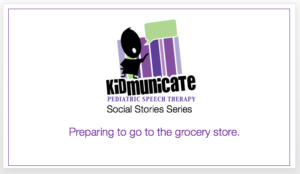

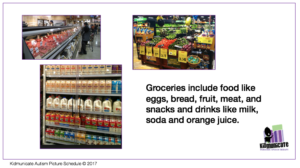
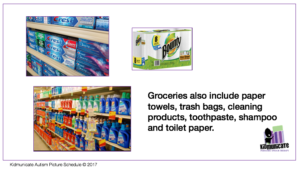
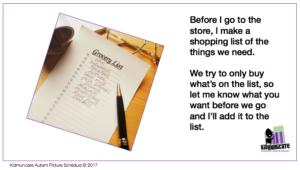

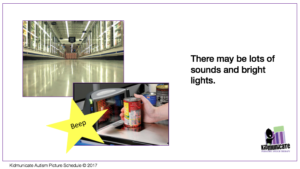

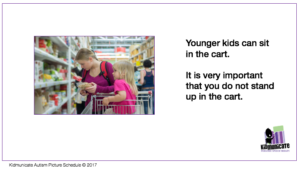
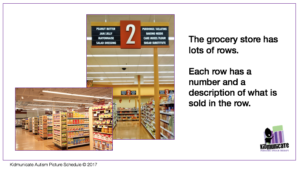
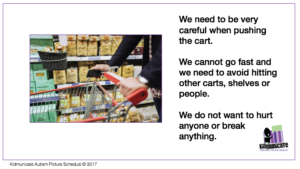
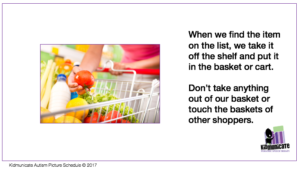
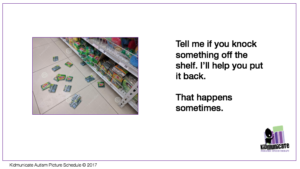

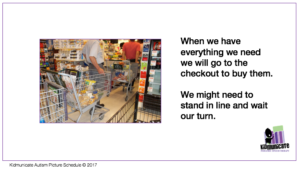
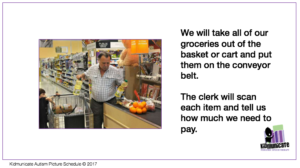
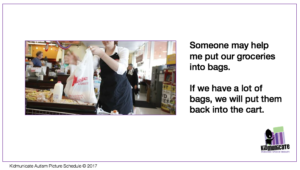
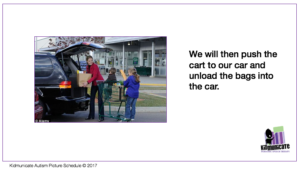
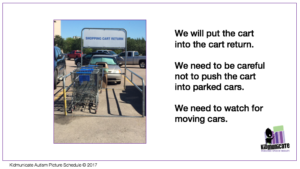
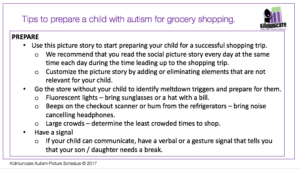

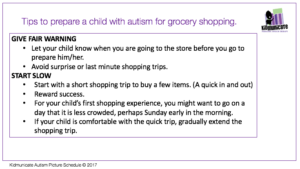
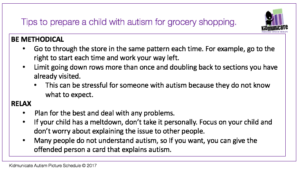


Hello!
I am a Special Education Consultant in Pennsylvania. A teacher I am working with today told me she is beginning to work with her students on going grocery shopping. She teaches in a Primary Autistic Support classroom. The parents of her students have not been successful with taking their children to grocery stores. When she said that she was planning to write a social story this weekend and look for resources, I googled the topic and this appeared.
Thank you for this most valuable resource. The teacher is thrilled!!!
Lynn
You are so welcome. If the teacher wants the Powerpoint version to customize please send us an email. All the best to you.
Hello, I am a Supports Coordinator at a CMH. Do you have copies of these flash cards that you can send me? One of my clients struggles with grocery shopping and I found this amazing resource! It will be so valuable to many of my clients 🙂
Hi Katie, Happy to help. We do not have flashcards, but we will send you the Powerpoint Presentation so you can print it out. We hope it helps.
This is so wonderful. I have a parent I am working with who could really use a social story like this for grocery shopping. She has medical needs and is having more trouble as he gets older shopping with him. Can you send to me the power point version so I can make it into a book for her to read to her son?
I noticed in another post that you mentioned this as an option.
Hi, great resource! Could you send me the powerpoint?, I work at an educational facility that is taking our students to the grocery store on a community trip. Many of these slides would be helpful
What a fabulous resource. I am new to working with autistic students and have been informed I will be taking some of my children grocery shopping. I’m sure this is going to pave the way nicely so we have a positive experience. I’d love it if you could send me the powerpoint please.
Hi Anita, Thanks for the compliment. I will send you the powerpoint today. All the best with your work.
I was referred to this site by my son’s teacher. My son is 5 and at this time he has no sensory issues. The issue I have with him is him throwing tantrums and screaming and kicking and falling to the floor because he can’t get candy or cereal or anything he sees that he want. I need something relevant to that. I dread taking him to the grocery store
I will certainly send you the Grocery Store Social Story. Check your email. We hope it helps.
HI!
Can you please send me this so that I can print it for a family? Thank you so much for the awesome resources that you provide.
Hi, can you please send me the powerpoint so I can do this with my ABA students?
Thanks!
Hi, I just found this site while searching for resources. A parent of a child I work with is struggling with grocery shopping trips. I would be very grateful if you could send me the Social Story. What a fantastic resource you’re providing, thanks!
HI, I work with a family that is having a really hard time with grocery trips. Can I please get a copy of this powerpoint to help during our sessions . Thank you
I would also love to get a copy of this Powerpoint. I am trying to help my stepson to be more expected on shopping trips. He often runs around/away and often shouts or tries to climb on things. I’d like to personalize the PPT to address those behaviors and show more expected grocery store behaviors.
Thank you for creating this story!